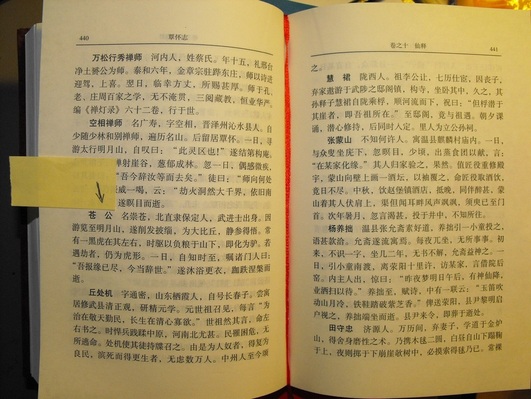TanHuai (覃怀) records (1728)
The TanHuai records (覃怀志) are historical local records dating back from the 7th year of the YongZheng (雍正) Emperor (i.e. 1728), that gather various information (geography, history, economy, etc.) of the formerly called TanHuai county of Henan province, an area located now in the JiaoZuo (焦作) prefecture of Henan. Starting from the year 2000, several pseudo-historical publications have come out that have related the origin of BajiQuan to the YueShan (岳山, or 月山) temple located in Bohai county of JiaoZuo prefecture. According to these publications, the founder of BajiQuan would be the abbot CangGong (苍公) who resided in the temple during the 12th century, and would have created BajiQuan during his seclusion in the temple. Here and there, some quotes from the TanHuai records saying that "CangGong created BajiQuan" are frequently cited in order to bring evidence supporting this hypothesis.
Above is a picture of the paragraph of the TanHuai records concerning the life of CangGong that is frequently cited. This part can be translated as :
“Cang Gong, called “the supreme Cang”, was from Baoding in north Hebei. He had passed the highest imperial military examinations. Because he visited the Ming YueShan mountain, he then shaved his head, became a high monk and reached a high level of consciousness in seclusion. He frequently had a black tiger at his sides. Sometimes he was driving the tiger down the mountain to carry some food, and the tiger was taking the shape of a donkey. If he encountered some bandits, the donkey was still having the shape of a tiger. One day, he realised his time has come, he advised all his students : “my life is coming to its end, I will die now”. He washed himself and put on clean clothes, his sat down with crossed legs, reached Nirvana and died.”
As one can see, the original records do not mention anything relating CangGong to BajiQuan. Apart from this paragraph, the records contain a few lines giving some historical details about when the temple was built, and there are a few poems about the temple and one about CangGong's cave, but in these sections there is again no mention of BajiQuan. Moreover, the whole records do not mention any martial art activity of any kind related to YueShan temple or to CangGong.
As a consequence, if tracing the origin of BajiQuan to YueShan temple can be an interesting hypothesis, it is however not supported by any historical written reference ...

